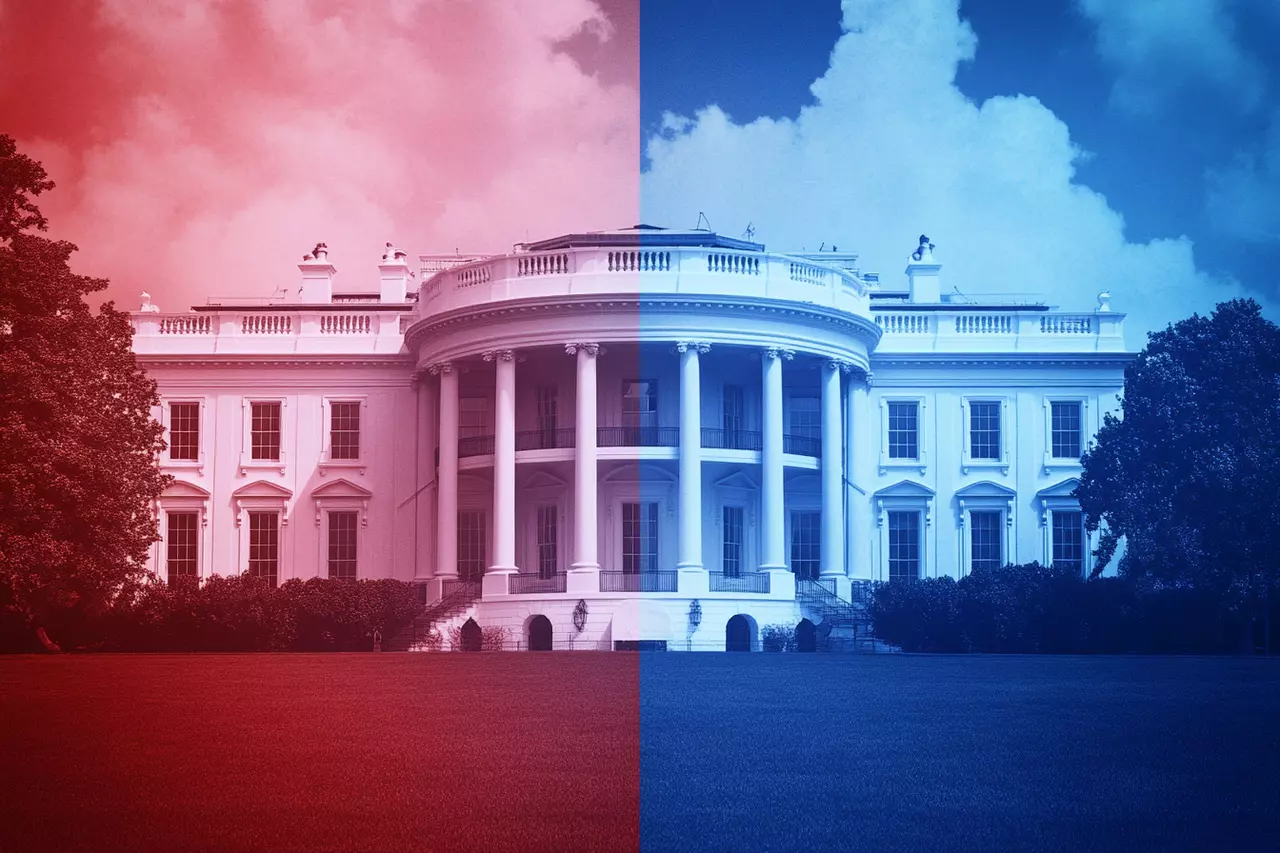

Trump vs. Harris: Where They Stand on Key Issues Impacting Americans
The 2024 presidential election presents voters with a stark choice between Vice President Kamala Harris and former President Donald Trump—two candidates with sharply different policies and visions for the future. From health care to foreign policy, their approaches couldn’t be more distinct.
Here’s a breakdown of where they stand on the key issues shaping the race.

HOUSING
Housing affordability has become a pressing issue for millions of Americans. With home prices skyrocketing and interest rates climbing, many first-time buyers are finding it harder than ever to secure a mortgage. Renters aren’t faring much better, facing steep rent hikes that make saving for the future nearly impossible.
As the housing crisis intensifies, it’s become a pivotal topic in the 2024 presidential race, with Vice President Kamala Harris and former President Donald Trump offering starkly different solutions.
Curious to see how their housing plans stack up? Read on!
Kamala Harris' Position on Housing
Vice President Kamala Harris is tackling the housing crisis head-on with a bold, comprehensive plan. Her strategy aims to boost the supply of homes, offer crucial financial support to first-time homebuyers and rein in corporate landlords to create a fairer, more affordable housing market.
Increase Home Construction:
- Proposes building 3 million new homes over four years, increasing annual homebuilding by more than 50%.
- Suggests a $40 billion "innovation fund" to support alternative construction models and local supply efforts.
First-Time Homebuyer Assistance:
- Offers a $25,000 tax credit for down-payment assistance to help more than 4 million households purchase their first home.
Targeting Corporate Landlords:
- Seeks to curb corporate practices in rental housing and prevent large property owners from coordinating rental pricing and supply information.
Low-Income Housing Production:
- Supports an increase in the tax credit that drives low-income housing production nationwide.
Making Federal Land Available:
- Shares the idea of utilizing federally owned land for housing development, though with few details on implementation.
Photography: CHUTTERSNAP on Unsplash

Donald Trump's Position on Housing
Former President Donald Trump’s housing plan takes a different approach, focusing on slashing demand by tightening immigration and cutting back on regulations. He’s also pushing for the use of federal land for new developments and promises to lower interest rates, aiming to make housing more affordable by drastically reshaping the market from the ground up.
Linking Housing and Immigration:
- Proposes mass deportations of undocumented immigrants, suggesting this would reduce housing demand and potentially lower costs.
- Some experts raise concerns that this could impact the housing construction workforce, possibly leading to higher home prices.
Deregulation:
- Aims to reduce regulations that may slow down homebuilding efforts.
- Opposes federal mandates for affordable housing development in wealthier areas, supporting local control over zoning regulations.
Lowering Interest Rates:
- Advocates for lowering interest rates to make mortgages more affordable, while acknowledging that the Federal Reserve controls rate-setting decisions independently.
Preserving Suburbs:
- Opposes policies that encourage affordable housing in suburban areas, expressing concern that such measures could fundamentally change suburban communities.
Making Federal Land Available:
- Proposes making more federal land available for housing development, with limited details on the specific implementation of this plan.
The Takeaway
Both candidates are taking very different routes to tackle the housing affordability crisis. Harris is focused on boosting the supply of homes and helping first-time buyers get a foot in the door, while Trump ties the issue to broader immigration and economic policies.
Photography: Tom Rumble on Unsplash

TAX POLICY
Taxes are always top of mind for Americans as they directly impact household budgets, paychecks and the overall economy. At the heart of the tax debate are key questions: Who should carry the tax burden? Should taxes be cut, and if so, how will changes affect the deficit and economic growth?
Former President Donald Trump and Vice President Kamala Harris have laid out dramatically different tax plans, each shaped by their unique priorities and visions for the future of the country.
Here’s a quick breakdown of where they stand on tax policy.
Donald Trump’s Position on Tax Policy
Former President Donald Trump is all about tax cuts, aiming to spark economic growth by putting more money into the hands of businesses and wealthy leaders who, he believes, will reinvest in the economy. At the same time, he’s pushing for bold tariffs to ramp up revenue and protect U.S. interests on the global stage.
Extend and Make Permanent 2017 Tax Cuts:
- Wants to maintain the provisions from the 2017 Tax Cuts and Jobs Act, which are set to expire in 2025. This includes higher standard deductions, a lower top marginal tax rate and bigger child tax credits.
Lower Corporate Tax Rate:
- Proposes reducing the corporate tax rate to 15% from the current 21%.
Targeted Tax Cuts:
- Has mentioned exempting certain incomes, such as Social Security and overtime, from taxation.
Tariffs on Imports:
- Proposes a 10% tax on all imports to the U.S. and a 60% tariff on goods coming from China, aiming to generate additional tax revenue and protect domestic industries.
Impact on Deficit and Economy:
- Trump's tax cuts may lead to an increase in the deficit, though he argues that lowering taxes will stimulate economic growth. His tariff proposals aim to generate additional revenue, but some suggest they could also raise costs for consumers.
Photography: Alexander Grey on Unsplash

Kamala Harris' Position on Tax Policy
Vice President Kamala Harris says that she's putting lower- and middle-income Americans at the forefront of her tax plan, offering targeted tax credits to provide relief. At the same time, she's making sure that high earners and big corporations pay their fair share to boost federal revenues.
Child Tax Credit Expansion:
- Proposes increasing the child tax credit to $3,000 per child, and $3,600 for children under five, with a $6,000 credit for the first year.
Support for Low-Income Earners:
- Plans to exempt tip income from taxation.
- Expands housing tax credits and provides down-payment support for first-time homebuyers.
Taxing High-Income Individuals and Corporations:
- Seeks to raise the corporate tax rate from 21% to 28%.
- Plans to increase the long-term capital gains tax for high earners.
- Proposes a billionaire minimum tax to ensure the wealthiest pay a fair share.
- Suggests quadrupling the tax on stock buybacks to reduce corporate tax loopholes.
Focus on Reducing Deficit Impact:
- Harris’s tax plan includes revenue-raising measures to offset the costs of tax credits and expansions, aiming to balance economic support with fiscal responsibility.
The Takeaway
Harris and Trump’s tax plans could have a big impact on everything from the federal deficit to economic growth and your wallet. Harris zeroes in on targeted relief and making corporations pay their fair share, while Trump pushes for sweeping tax cuts and aggressive tariffs. With such dramatically different approaches, tax policy is shaping up to be a major battleground as voters decide who’s best equipped to steer the economy forward.
Photography: Kelly Sikkema on Unsplash

IMMIGRATION
With concerns ranging from border security to the status of undocumented migrants, immigration remains a hot topic for many Americans. The debate centers on how best to manage the border, enforce deportation policies and provide pathways to legal status for those already in the country.
Vice President Kamala Harris and former President Donald Trump have taken drastically different stances on immigration. Here is a breakdown of their positions.
Kamala Harris' Position on Immigration
Kamala Harris emphasizes a balanced approach, supporting stronger border security alongside a pathway to citizenship for undocumented immigrants.
Border Security:
- Initially supported decriminalizing illegal border crossings but has since shifted to a tougher stance.
- Supports a bipartisan bill adding 1,500 border agents, 10,000 detention beds and doubling deportation flights.
- Opposes the border wall, calling it a waste of money, but would sign legislation to continue some construction.
Comprehensive Immigration Reform:
- Pledges to pass a comprehensive immigration bill that includes "strong border security" and an earned pathway to citizenship for undocumented immigrants.
Asylum Policy:
- Supported an executive action limiting asylum claims and no longer advocates for decriminalizing illegal border crossings.
DREAMers:
- Has not outlined specific plans for DREAMers in current proposals but generally supports protections for those brought to the U.S. as minors.
Photography: Barbara Zandoval on Unsplash

Donald Trump’s Position on Immigration
Trump’s immigration plan centers on tougher enforcement, mass deportations and doubling down on building a more formidable border wall to strengthen U.S. security.
Mass Deportations:
- Proposes deporting the estimated 11 million undocumented immigrants, using the National Guard, military and local law enforcement for door-to-door enforcement.
Border Wall:
- Promises to finish the southern border wall and criticized Harris’s stance against it.
- Built about 500 miles of wall during his presidency, most of it replacing existing barriers.
Restricting Legal Immigration:
- Advocates for a merit-based immigration system that prioritizes skilled workers and reduces family-based immigration.
Opposition to Comprehensive Reform:
- Opposed bipartisan immigration reform bills, focusing on his own hardline measures.
The Takeaway
Trump takes a strict, enforcement-heavy approach, while Harris favors a mix of stronger border control and pathways to citizenship, reflecting their deeply contrasting immigration visions for the country.
Photography: Barbara Zandoval on Unsplash

HEALTH CARE
Health care is a top concern for millions of Americans, with fears about soaring prescription drug prices, the future of Medicare and Medicaid, and what lies ahead for the Affordable Care Act (ACA). Former President Donald Trump and Vice President Kamala Harris have sharply contrasting solutions to these critical challenges.
Here’s a quick snapshot of where each stands on the issue.
Donald Trump’s Position on Health Care
Trump’s approach zeroes in on slashing government spending, rolling back health care regulations and dismantling the Affordable Care Act, with a promise to replace it with something better. His goal? A leaner, more cost-efficient health care system.
Repealing the Affordable Care Act:
- Seeks to repeal the ACA but offers no detailed replacement plan. Promises to "run it as good as it can be run" in the meantime.
Lowering Prescription Drug Costs:
- Proposes to revive efforts to tie Medicare drug reimbursements to international prices.
- Supports transparency in hospital pricing and previously capped insulin costs for certain Medicare beneficiaries.
Medicare and Medicaid:
- Opposes cuts to Medicare, but supports shifting more enrollees to Medicare Advantage, the private option.
- Approved Medicaid work requirements during his presidency and proposed limiting federal funding for Medicaid.
Public Health and COVID-19:
- Promises to end all COVID-related mandates and opposes federal intervention in vaccine or mask mandates in schools.
Photography: National Cancer Institute on Unsplash

Kamala Harris' Position on Health Care
Harris is championing a plan to expand health care access, safeguard the Affordable Care Act and tackle rising health care costs—especially when it comes to making prescription drugs more affordable for everyone.
Protecting and Strengthening the Affordable Care Act:
- Supports making ACA premium subsidies permanent and expanding them.
- Opposes any effort to repeal the ACA, emphasizing its role in expanding coverage.
Lowering Prescription Drug Costs:
- Helped pass the Inflation Reduction Act, which caps Medicare insulin costs at $35 and caps out-of-pocket drug spending at $2,000.
- Advocates speeding up Medicare drug price negotiations and expanding the $2,000 cap to everyone, not just seniors.
Medicare and Medicaid:
- Vows to protect and expand Medicare, with a focus on preventing cuts to the program.
- Supports Medicaid expansions, including postpartum coverage for maternal health.
Eliminating Medical Debt:
- Worked to remove medical debt from credit reports and supports forgiving medical debts through government initiatives.
The Takeaway
Trump zeroes in on deregulation and cost-cutting strategies, while Harris is all about expanding access and driving down health care costs. With health care being a top priority for voters, these sharp contrasts will play a crucial role as the election heats up.
Photography: Richard Catabay on Unsplash

FOREIGN POLICY
Foreign policy is a major concern for Americans, shaping national security, trade and global stability. From maintaining strong alliances to navigating tensions with powers like China and Russia, and addressing conflicts in the Middle East, these issues are at the heart of this election season.
Vice President Kamala Harris and former President Donald Trump offer vastly different visions for America’s role on the world stage, each reflecting their broader political philosophies.
Here’s where they stand.
Kamala Harris' Position on Foreign Policy
Harris takes a multilateral approach, emphasizing alliances, diplomacy and addressing global challenges like climate change and human rights.
Israel and Gaza:
- Supports a cease-fire and ongoing peace talks, backing a two-state solution for Palestinians and Israelis.
- Advocates for humanitarian aid to Gaza but does not support halting arms to Israel.
Iran and Lebanon:
- Condemns Iran’s support for militant groups like Hezbollah and seeks to curb Iran's nuclear capabilities through diplomacy.
- Supports sanctions on Iran for its human rights abuses and regional destabilization.
Russia and Ukraine:
- Strongly supports Ukraine, pledging continued military and economic aid against Russian aggression.
- Opposes Trump’s soft stance on Putin, warning that his leadership would weaken U.S. support for Ukraine.
China:
- Advocates maintaining tariffs on China, while strengthening alliances in the Asia-Pacific region.
- Supports maintaining Taiwan’s security and preventing Chinese aggression in the region.
Latin America:
- Focuses on addressing the root causes of migration and improving relations with Central American countries.
- Opposes blanket tariffs on imports from Latin America, warning they would hurt the U.S. economy.
NATO and Europe:
- Strongly supports NATO and strengthening alliances in Europe.
- Opposes Trump’s past rhetoric on withdrawing the U.S. from NATO.
Photography: UX Gun on Unsplash

Donald Trump’s Position on Foreign Policy
Trump pushes a bold "America First" strategy, putting U.S. economic interests front and center while adopting a more deal-focused, transactional approach with both allies and adversaries.
Israel and Gaza:
- Supports Israel’s military operations and has not opposed potential Israeli rule over Gaza.
- Brokered the Abraham Accords, establishing diplomatic ties between Israel and some Arab states.
Iran and Lebanon:
- Enforced a “maximum pressure” campaign on Iran, including sanctions and the withdrawal from the Iran nuclear deal.
- Opposes diplomatic engagement with Iran unless it ceases its support for militant groups.
Russia and Ukraine:
- Promises to end the Ukraine war quickly but offers no details, raising concerns he may cut U.S. military aid to Ukraine.
- Has expressed admiration for Putin, drawing criticism for a perceived pro-Russian stance.
China:
- Advocates expanding tariffs on Chinese goods, promoting a tough stance in trade wars.
- Has praised Chinese leadership but criticizes their trade practices.
Latin America:
- Supports harsh immigration policies and potential military action against drug cartels in Mexico.
- Promises to impose blanket tariffs on all imports, which could affect Latin American trade partners.
NATO and Europe:
- Has repeatedly questioned NATO’s value, raising concerns about U.S. withdrawal from the alliance.
- Prefers bilateral deals over multilateral agreements, which could weaken U.S. influence in Europe.
The Takeaway
Kamala Harris champions diplomacy and building strong global alliances, while Donald Trump takes a bold "America First" approach, relying on economic power and military strength to get results. Their contrasting strategies highlight two very different visions for America’s role on the world stage.
Photography: Meizhi Lang on Unsplash
